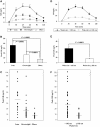The effects of central adiposity on growth hormone (GH) response to GH-releasing hormone-arginine stimulation testing in men
- PMID: 18765508
- PMCID: PMC2582562
- DOI: 10.1210/jc.2008-1333
The effects of central adiposity on growth hormone (GH) response to GH-releasing hormone-arginine stimulation testing in men
Abstract
Context: The relative contribution of central adiposity vs. weight on GH response to stimulation testing in obesity is not known.
Objective: We aimed to assess the contribution of weight and specific measures of central and peripheral adiposity to GH response to GHRH-arginine testing in lean, overweight, and obese men.
Design: A total of 75 men [mean age, 44.3+/-1.1 yr; body mass index (BMI), 28.8+/-0.7 kg/m2] were investigated. Subjects were classified as lean (BMI<25 kg/m2; n=23), overweight (BMI>or=25 and <30 kg/m2; n=28), or obese (BMI>or=30 kg/m2; n=24). Subjects were also stratified by waist circumference (WC) (<102 cm, n=47; >or=102 cm, n=28). Body composition and regional adiposity were assessed by anthropometrics, dual-energy x-ray absorptiometry (DEXA), and abdominal computed tomography (CT) scans.
Results: Peak stimulated GH was 36.4+/-5.4, 16.6+/-2.9, and 7.6+/-0.9 microg/liter among lean, overweight, and obese subjects, respectively (P<0.001 for all comparisons). Peak stimulated GH was 26.9+/-3.4 microg/liter among subjects with WC less than 102 cm compared to 7.9+/-0.9 microg/liter among subjects with WC of 102 cm or greater (P<0.0001). Separate multivariate models using anthropometric, DEXA, and CT-derived measures of central adiposity demonstrated strong associations between peak stimulated GH and measures of central adiposity including WC, trunk fat by DEXA, and visceral adiposity by CT, controlling for age, BMI, and more general measures of adiposity. WC was independently associated with peak GH response to GHRH-arginine in a model including age, BMI, and hip circumference. In this model, BMI was no longer significant, and peak GH was reduced 1.02 microg/liter for each 1 cm increase in WC (P=0.02).
Conclusions: GH response to GHRH-arginine testing is reduced in both overweight and obese subjects and negatively associated with indices of central abdominal obesity including WC, trunk fat, and visceral adipose tissue. The use of waist circumference, as a surrogate for central adiposity, adds predictive information to the determination of GH response, independent of BMI.
Figures

Comment in
-
Central adiposity as an important confounder in the diagnosis of adult growth hormone deficiency.J Clin Endocrinol Metab. 2008 Nov;93(11):4221-3. doi: 10.1210/jc.2008-2020. J Clin Endocrinol Metab. 2008. PMID: 18987280 No abstract available.
Similar articles
-
Body fat mass is a strong and negative predictor of peak stimulated growth hormone and bone mineral density in healthy adolescents during transition period.Horm Metab Res. 2013 Sep;45(10):748-53. doi: 10.1055/s-0033-1347243. Epub 2013 Aug 2. Horm Metab Res. 2013. PMID: 23913118 Clinical Trial.
-
Abdominal adiposity and physical fitness are major determinants of the age associated decline in stimulated GH secretion in healthy adults.J Clin Endocrinol Metab. 1996 Jun;81(6):2209-15. doi: 10.1210/jcem.81.6.8964853. J Clin Endocrinol Metab. 1996. PMID: 8964853
-
Gonadal status and body mass index jointly determine growth hormone (GH)-releasing hormone/GH-releasing peptide synergy in healthy men.J Clin Endocrinol Metab. 2008 Mar;93(3):944-50. doi: 10.1210/jc.2007-1388. Epub 2007 Dec 11. J Clin Endocrinol Metab. 2008. PMID: 18073313 Free PMC article. Clinical Trial.
-
Visceral adiposity and inflammatory bowel disease.Int J Colorectal Dis. 2021 Nov;36(11):2305-2319. doi: 10.1007/s00384-021-03968-w. Epub 2021 Jun 9. Int J Colorectal Dis. 2021. PMID: 34104989 Review.
-
Adiposity has a greater impact on hypertension in lean than not-lean populations: a systematic review and meta-analysis.Eur J Epidemiol. 2014 May;29(5):311-24. doi: 10.1007/s10654-014-9911-6. Epub 2014 May 17. Eur J Epidemiol. 2014. PMID: 24838697 Review.
Cited by
-
Serum insulin-like growth factor-1 concentrations are reduced in severely obese women and raise after weight loss induced by laparoscopic adjustable gastric banding.Obes Surg. 2012 Aug;22(8):1276-80. doi: 10.1007/s11695-012-0669-1. Obes Surg. 2012. PMID: 22648796
-
Relationship between serum IGF-1 and skeletal muscle IGF-1 mRNA expression to phosphocreatine recovery after exercise in obese men with reduced GH.J Clin Endocrinol Metab. 2015 Feb;100(2):617-25. doi: 10.1210/jc.2014-2711. Epub 2014 Nov 6. J Clin Endocrinol Metab. 2015. PMID: 25375982 Free PMC article.
-
Metabolic effects of a growth hormone-releasing factor in obese subjects with reduced growth hormone secretion: a randomized controlled trial.J Clin Endocrinol Metab. 2012 Dec;97(12):4769-79. doi: 10.1210/jc.2012-2794. Epub 2012 Sep 26. J Clin Endocrinol Metab. 2012. PMID: 23015655 Free PMC article. Clinical Trial.
-
Prevalence of the metabolic syndrome in moderately-severely obese subjects with and without growth hormone deficiency.J Endocrinol Invest. 2010 Mar;33(3):171-7. doi: 10.1007/BF03346577. Epub 2009 Sep 30. J Endocrinol Invest. 2010. PMID: 19794297
-
Sensitivity and specificity of the macimorelin test for diagnosis of AGHD.Endocr Connect. 2021 Jan;10(1):76-83. doi: 10.1530/EC-20-0491. Endocr Connect. 2021. PMID: 33320108 Free PMC article.
References
-
- Iranmanesh A, Lizarralde G, Veldhuis JD 1991 Age and relative adiposity are specific negative determinants of the frequency and amplitude of growth hormone (GH) secretory bursts and the half-life of endogenous GH in healthy men. J Clin Endocrinol Metab 73:1081–1088 - PubMed
-
- Riedel M, Hoeft B, Blum WF, von zur Muhlen A, Brabant G 1995 Pulsatile growth hormone secretion in normal-weight and obese men: differential metabolic regulation during energy restriction. Metabolism 44:605–610 - PubMed
-
- Van Dam EW, Roelfsema F, Helmerhorst FH, Frolich M, Meinders AE, Veldhuis JD, Pijl H 2002 Low amplitude and disorderly spontaneous growth hormone release in obese women with or without polycystic ovary syndrome. J Clin Endocrinol Metab 87:4225–4230 - PubMed
-
- Vizner B, Reiner Z, Sekso M 1983 Effect of l-dopa on growth hormone, glucose, insulin, and cortisol response in obese subjects. Exp Clin Endocrinol 81:41–48 - PubMed
-
- Williams T, Berelowitz M, Joffe SN, Thorner MO, Rivier J, Vale W, Frohman LA 1984 Impaired growth hormone responses to growth hormone-releasing factor in obesity. A pituitary defect reversed with weight reduction. N Engl J Med 311:1403–1407 - PubMed
Publication types
MeSH terms
Substances
Grants and funding
LinkOut - more resources
Full Text Sources
Other Literature Sources

